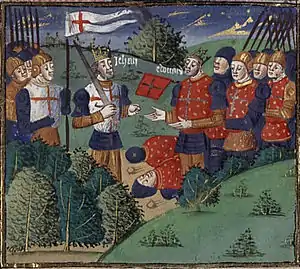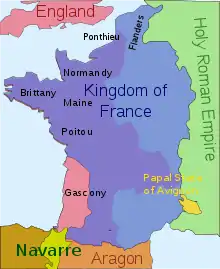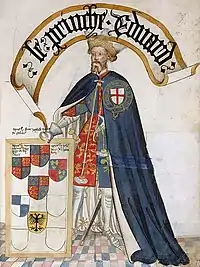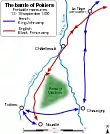Black Prince's chevauchée of 1356
The Black Prince's chevauchée of 1356, which began on 4 August at Bordeaux and ended with the Battle of Poitiers on 19 September, was a devastating raid of Edward of Woodstock, Prince of Wales (known as the Black Prince), the eldest son of King Edward III of England. This expedition of the Black Prince devastated large parts of Bergerac, Périgord, Nontronnais, Confolentais, Nord-Ouest, Limousin, La Marche, Boischaut, Champagne Berrichonne, Berry, Sologne, south of Touraine and Poitou.
| Chevauchée of the Black Prince | |||||||
|---|---|---|---|---|---|---|---|
| Part of Hundred Years' War | |||||||
 Capture of King John II of France at the Battle of Poitiers | |||||||
| |||||||
| Belligerents | |||||||
|
|
| ||||||
| Commanders and leaders | |||||||
|
|
| ||||||
| Strength | |||||||
| 9,000 | |||||||
Background
Since the Norman Conquest of 1066, English monarchs had held titles and lands within France, the possession of which made them vassals of the kings of France.[1] Following a series of disagreements between Philip VI of France (r. 1328–1350) and Edward III of England (r. 1327–1377), on 24 May 1337 Philip's Great Council in Paris agreed that the lands held by Edward III in France should be taken back into Philip's hands on the grounds that Edward III was in breach of his obligations as a vassal. This marked the start of the Hundred Years' War, which was to last 116 years.[2]
Before the war commenced, well over 1,000 ships a year departed Gascony. Among their cargoes were more than 200,000,000 imperial pints (110,000,000 litres; 240,000,000 US pints) of wine.[3][4] The duty levied by the English Crown on wine from Bordeaux, the capital of Gascony, was more than all other customs duties combined and by far the largest source of state income. Bordeaux had a population of more than 50,000, greater than London's,[5] and Bordeaux was possibly richer. However, by this time English Gascony had become so truncated by French encroachments that it relied on imports of food, mostly from England.[6] Any interruptions to regular shipping were liable to starve Gascony and financially cripple England; the French were well aware of this.[7]

Although Gascony was the cause of the war, Edward III was able to spare few resources for its defence. In most campaigning seasons the Gascons had to rely on their own resources and had been hard-pressed by the French.[8][9] Typically the Gascons could field 3,000–6,000 men, the large majority infantry, although up to two-thirds of them would be tied down in garrisons.[10] In 1345 and 1346 Henry, Earl of Lancaster, led a series of successful campaigns in Aquitaine and the Anglo-Gascons were able to push the focus of the fighting away from the heart of Gascony.[11][12][13] This guaranteed Gascony's food supplies and put Gascon territory beyond reach of French advances.[14] Numerous French-held castles and small towns remained within what was nominally English territory, just as the English had outposts deep within French territory.[15]
The French port of Calais fell to the English on 3 August 1347 after an eleven-month siege and shortly after the Truce of Calais was signed.[16] This was partially the result of both countries being financially exhausted.[17] The same year the Black Death reached northern France and southern England,[18] resulting in the death of approximately 45 per cent of the population.[19] Fighting continued in Picardy and Brittany, and especially fiercely in south-west France, where the English raided deep into French territory, but no large forces took the field.[20] Negotiations for a permanent peace commenced in 1353 in Avignon under the auspices of Pope Innocent VI and the war died down to skirmishes and small-scale raids.[21] These talks collapsed in early 1355.[22] In April 1355 Edward III and his council, with the treasury in an unusually favourable financial position, decided to launch offensives that year in both northern France and Gascony.[23][24]
Black Prince arrives

Edward III's eldest son, Edward of Woodstock, later commonly known as the Black Prince, was given the Gascon command[25][26] and began assembling men, shipping and supplies.[27] He was scheduled to sail in July, but eventually set off on 9 September, arriving in Bordeaux, the capital of Gascony, on the 20th accompanied by 2,200 English soldiers.[4][28] The next day he was formally acknowledged as the king's lieutenant in Gascony, with plenipotentiary powers.[29][30] Gascon nobles reinforced him to a strength of somewhere between 5,000 and 6,000 and provided a bridging train[31] and a substantial supply train.[32][33]
Edward set out on 5 October on a chevauchée, also known as the grande chevauchée, which was a large-scale mounted raid. The Anglo-Gascon force marched from Bordeaux in English-held Gascony 300 miles (480 km) to Narbonne and back to Gascony, devastating a wide swathe of French territory and sacking many French towns on the way. John, Count of Armagnac, who commanded the local French forces, avoided battle, and there was little fighting during the campaign. While no territory was captured, enormous economic damage was done to France; the modern historian Clifford Rogers concluded that "the importance of the economic attrition of the chevauchée can hardly be exaggerated."[34]
Prelude

The expedition returned to Gascony on 2 December having marched 675 miles (1,100 km).[35] The English component resumed the offensive after Christmas[36] to great effect, and more than 50 French-held towns or fortifications were captured during the following four months.[37] including strategically important towns close to the borders of Gascony,[38] and others over 80 miles (130 km) away.[39] Local French commanders attempted no countermeasures.[40][41] Several members of the local French nobility went over to the English; the Black Prince received homage from them on 24 April 1356.[42][43]
Reinforcements of men and horses and supplies of food and materiel arrived from England during the spring, and at the start of August 1356 the Black Prince headed north on another chevauchée with an Anglo-Gascon force of 6,000. He penetrated as far as the Loire, then withdrew.[44][45]
The French deduced that the Prince of Wales was preparing to repeat his chevauchée of the autumn of 1355. King John II of France, then at the siege of Breteuil in Normandy, sent reinforcements to reinforce the army of the Dauphin Charles, positioned at Bourges, to support the possessions and cities of Languedoc.
Aftermath
The chevauchée of the Black Prince in 1356 was very successful for the English. The defeat of the French army at Poitiers was more humiliating for the French than that of Crécy in 1346. At Poitiers and Crécy, the French used identical strategies, which resulted in identical failures. In 10 years, the French had not evolved their military technique. With the capture of John II, this led to a lengthy period of instability within France.
Citations and sources
Citations
- Prestwich 2007, p. 394.
- Sumption 1990, p. 184.
- Rodger 2004, pp. xix–xx, 79.
- Curry 2002, p. 40.
- Sumption 1990, pp. 39–40.
- Madden 2014, p. 10.
- Rodger 2004, pp. 79–80.
- Fowler 1961, pp. 139–140.
- Rogers 2004, p. 95.
- Fowler 1961, pp. 143–144.
- Harari 1999, pp. 385–386.
- Fowler 1969, pp. 67–71.
- Sumption 1990, pp. 541–550.
- Sumption 1990, pp. 547–549.
- Sumption 1990, p. 547.
- Sumption 1990, p. 585.
- Sumption 1990, p. 584.
- Deaux 1969, p. 122.
- Lewis 2016, p. 793.
- Burne 1999, p. 225.
- Sumption 1999, pp. 111–113.
- Burne 1999, p. 246.
- Sumption 1999, pp. 153, 160.
- Madden 2014, p. 6.
- Madden 2014, pp. 79ff.
- Sumption 1999, pp. 153–154.
- Sumption 1999, pp. 154–155.
- Sumption 1999, pp. 168, 175.
- Burne 1999, p. 251.
- Wagner 2006, p. 95.
- Burne 1999, p. 252.
- Madden 2014, pp. 190, 201, 209.
- Wagner 2006, p. 96.
- Rogers 1994, p. 101.
- Burne 1999, p. 258.
- Sumption 1999, pp. 191–192.
- Burne 1999, p. 259.
- Curry 2002, p. 43.
- Sumption 1999, pp. 191–193.
- Sumption 1999, p. 192.
- Madden 2014, p. 359.
- Sumption 1999, p. 193.
- Madden 2014, p. 347.
- Curry 2002, pp. 43, 45.
- Burne 1999, pp. 276–278.
Sources
- Burne, Alfred (1999) [1955]. The Crecy War. Ware, Hertfordshire: Wordsworth Editions. ISBN 978-1840222104.
- Curry, Anne (2002). The Hundred Years' War 1337–1453 (PDF). Oxford: Osprey Publishing (published 13 November 2002). ISBN 978-1841762692. Archived from the original (PDF) on 27 September 2018.
- Deaux, George (1969). The Black Death, 1347. London: Hamilton. OCLC 242352826.
- Fowler, Kenneth (1961). Henry of Grosmont, First Duke of Lancaster, 1310–1361 (PDF) (PhD thesis). Leeds: University of Leeds.
- Fowler, Kenneth Alan (1969). The King's Lieutenant: Henry of Grosmont, First Duke of Lancaster, 1310–1361. New York: Barnes & Noble. OCLC 164491035.
- Harari, Yuval Noah (1999). "Inter-frontal Cooperation in the Fourteenth Century and Edward III's 1346 Campaign". War in History. 6 (4): 379–395. doi:10.1177/096834459900600401. JSTOR 26013966. S2CID 59055741.
- Herbert J. Hewitt, The Black Prince’s Expedition of 1355-1357, Manchester, Manchester University Press, 1958.
- Lewis, Carenza (June 2016). "Disaster Recovery: New Archaeological Evidence for the Long-Term Impact of the 'Calamitous' Fourteenth Century". Antiquity. 90 (351): 777–797. doi:10.15184/aqy.2016.69. ISSN 0003-598X.
- Madden, Mollie Marie (2014). The Black Prince at War: The Anatomy of a Chevauchée (PDF) (PhD thesis). Minnesota: University of Minnesota.
- Prestwich, Michael (2007). Plantagenet England 1225–1360. Oxford: Oxford University Press. ISBN 978-0199226870.
- Rodger, N. A. M. (2004). The Safeguard of the Sea. London: Penguin. ISBN 978-0140297249.
- Rogers, Clifford J (1994). "Edward III and the Dialectics of Strategy, 1327-1360". Transactions of the Royal Historical Society. 4: 83–102. doi:10.2307/3679216. JSTOR 3679216. OCLC 931311378.
- Rogers, Clifford (2000). War Cruel and Sharp: English Strategy under Edward III, 1327–1360. Woodbridge, Suffolk: Boydell Press. ISBN 978-0851158044.
- Rogers, Clifford J. (2004). Bachrach, Bernard S.; DeVries, Kelly & Rogers, Clifford J (eds.). "The Bergerac Campaign (1345) and the Generalship of Henry of Lancaster". Journal of Medieval Military History. II. Woodbridge, Suffolk: Boydell & Brewer. ISBN 978-1843830405. ISSN 0961-7582.
- Sumption, Jonathan (1990). Trial by Battle. The Hundred Years' War. I. London: Faber and Faber. ISBN 978-0571200955.
- Sumption, Jonathan (1999). Trial by Fire. The Hundred Years' War. II. London: Faber and Faber. ISBN 0-571138969.
- Wagner, John A. (2006). Encyclopedia of the Hundred Years War (PDF). Westport, CT, US: Greenwood Press. ISBN 978-0313327360. Archived from the original (PDF) on 16 July 2018.